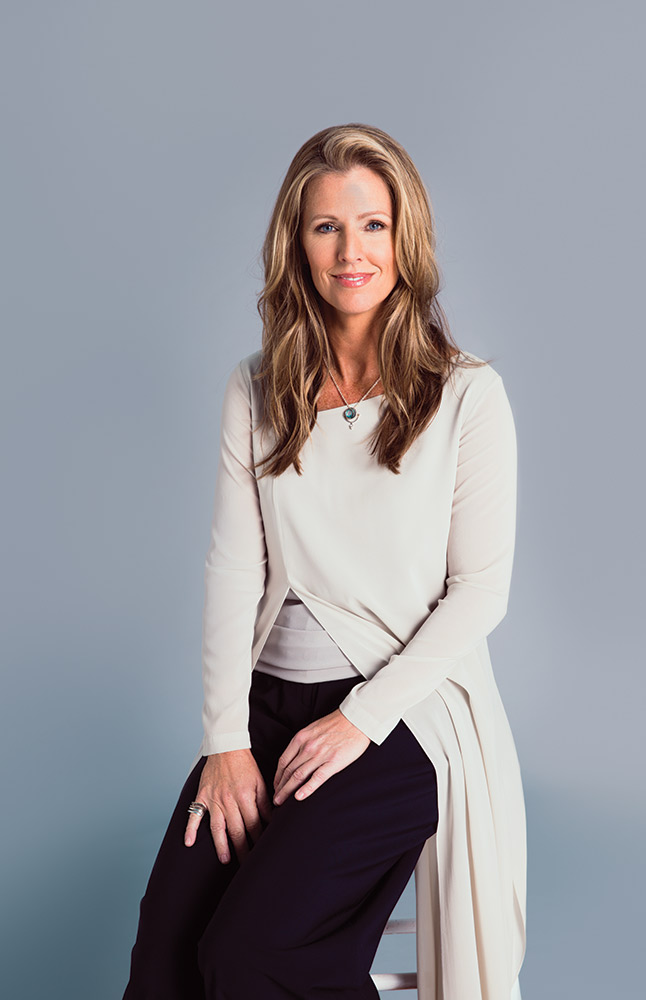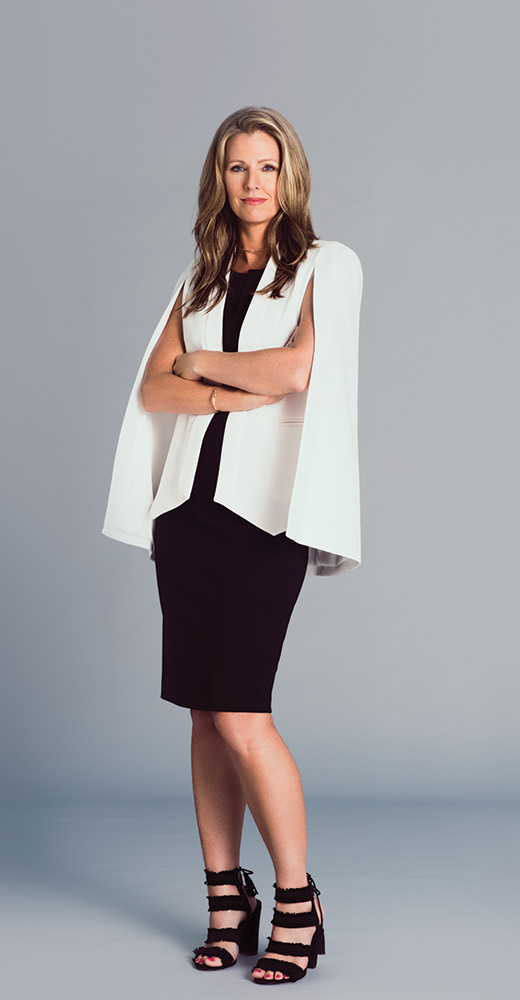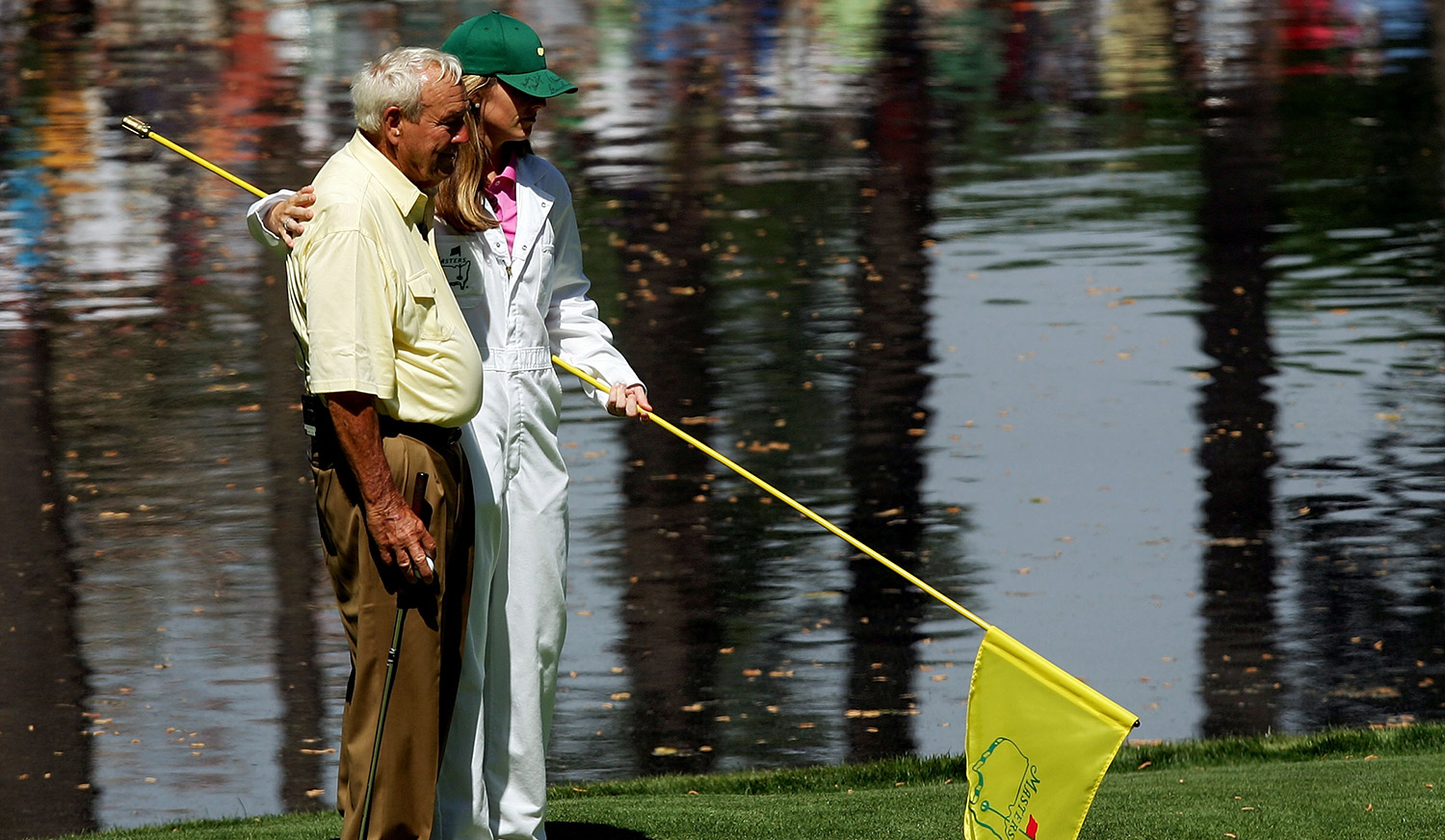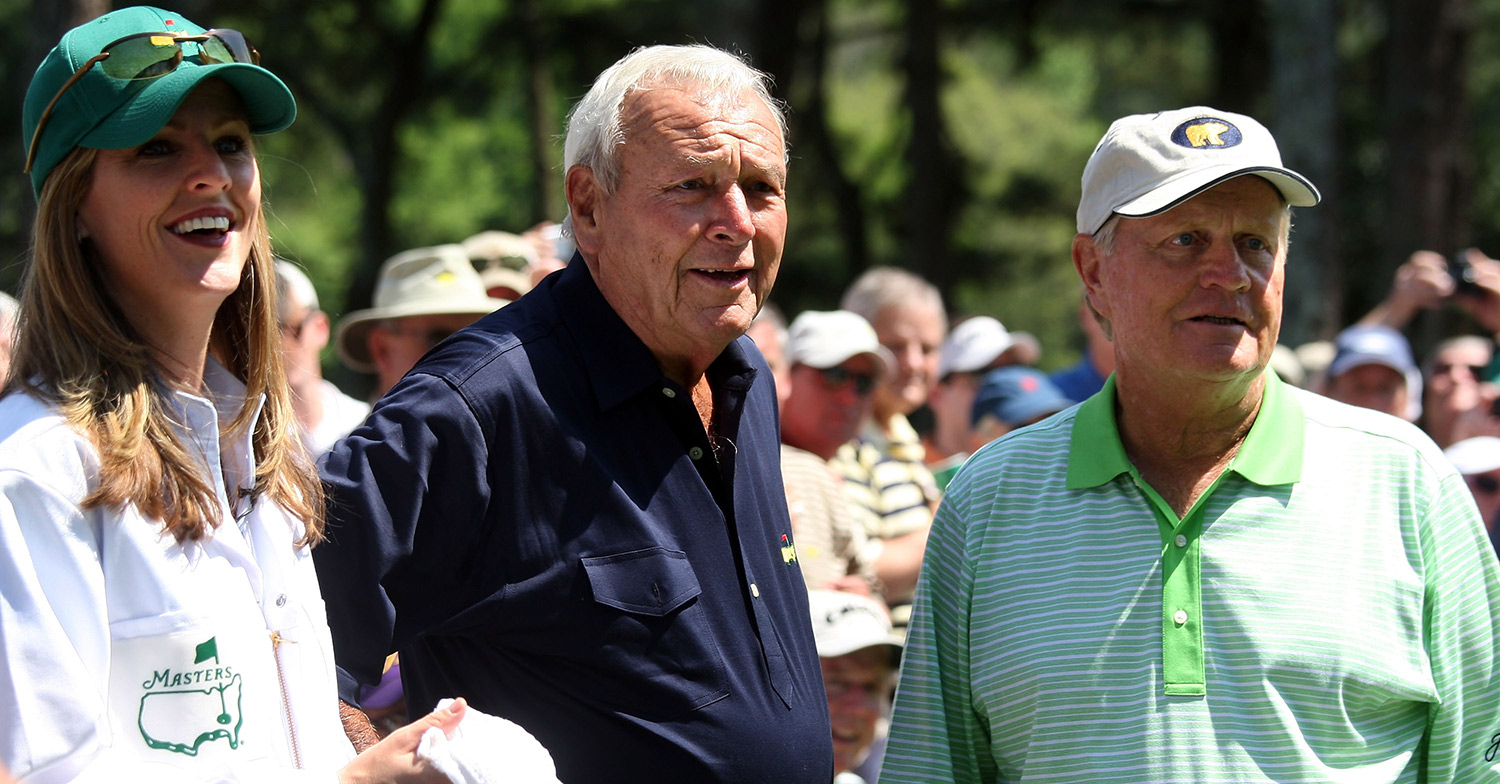
Kelly Tilghman, the Golf Channel presenter, spoke to Kingdom about life, work, family and caddying for Arnold Palmer
Words: Reade Tilley
Photography: Della Bass
“I thought it wasn’t going to happen, so I’d given up hope. And then, I think we were about a week out, I got the call that Mr. Palmer wanted me to caddy for him at the Masters.”
The oldest of five children and the only girl, Kelly Tilghman is a Golf Channel star. The first female lead announcer for the PGA TOUR and a former pro golfer herself, she’s navigated the predominantly male world of network television with grace while raising a 4-year-old daughter and, occasionally, surfing. She also found time to caddy for Arnold Palmer over several years of the Masters Par-3 contest—just one more once-in-a-lifetime experience for a woman who’s made a career out of them.

“[Palmer’s associate] Cori Britt invited me to meet him in the parking lot to go over the way that Arnold likes to have his bag run, and so I went to get my caddie jumper, my hat, got my ‘Palmer’ name to put on the back of my jumper, and immediately I went over to the parking lot to meet with Cori,” Tilghman remembers. “He’s walking me through the bag, where the golf balls are, where he has his tees—‘They have to be in these pockets in case Arnold goes there himself; they need to be there.’ And then Cori said, ‘OK, I’ve saved this pocket for last because this is where he keeps his pins, his umbrella pins; this is the most important pocket in the bag. He wants you to help him give a pin out to every possible patron that he can, so they can have a little piece of him at the end of the day, hand out as many of those pins as possible.’ There were hundreds of them in there.
“At the very end of all this, Cori said ‘You good?’ I said I’m nervous but I think I’m good. Then he said, ‘Oh by the way, little change of plans…’ Arnold was originally supposed to play with Mike Weir and Vijay Singh. But Arnie and Jack and Gary had lunch and thought, ‘what the hell, let’s do this!’ So they were playing together. My stomach dropped. I mean, I was thrilled, but I was way more nervous now.”

Tilghman handled herself brilliantly with the Big Three (she even hit a shot during the round, at Nicklaus’ suggestion) and it became the tradition that, while Palmer was in the Golf Channel booth on air with Kelly during the Arnold Palmer Invitational, he would invite her to caddie for him at the Masters again. Those invitations weren’t just the result of Tilghman’s friendship with Palmer, they were evidence of how far she’d come—and Kelly Tilghman came a long, long way. All the way from a family-owned golf course in North Myrtle Beach, just off a South Carolina highway.
“The suspension in the Cherokee Chief was terrible, but I was getting a big kick out of the bumps,” she remembers. “I watched [the course] come up from the ground up, from dirt to fairways. It was so impressionable for me as a kid.”
Kelly’s dad used to drive her over the grounds of what would eventually be Gator Hole Golf Course, which her family built and owned for many years. The track was one of Rees Jones’ earliest designs, and Tilghman says it provided the foundation for her success in the game. Additional credit, she says, goes to the fact that she grew up in a house on the third tee of Surf Golf & Beach Club, where her grandfather was a founding member.

“It was the perfect recipe for a little female golfer being born,” she says, “It was in the bloodline and in the business line; it was the perfect storm.”
Indeed, two of her relatives are in the South Carolina Hall of Fame as golfers: her grandfather Melvin Hemphill was a noted teaching pro who was coaching Jack Fleck when Fleck beat Ben Hogan in the 1955 U.S. Open at Olympic Club, and her great aunt Kathryn Hemphill was a dominant amateur who played on the 1938 Curtis Cup team with Patty Berg and Glenna Collett-Vare. Kelly’s parents were accomplished as well: her charismatic mother Kathryn made a successful career in media sales and her father Phil was Mayor of North Myrtle Beach and a businessman. The two were also pro Shag dancers (her mother is in the dance’s National Hall of Fame), making for a full life in their full house.
A young Kelly didn’t dance—“I can do the basic shuffle step, and that’s where it ends”—but she was on board with her family’s legacy of achievement, even if the discipline preached by her father, a Citadel graduate and former Army captain, didn’t take, not at first anyway. Sports did, however, and especially golf—kind of:
“I didn’t like to practice. My two best sports growing up were golf and basketball, though I played other sports [including football; she was the only girl on the team]. I loved basketball more because it was such a reactionary sport. I loved the team aspect, loved to sweat, loved everything about it. Golf was slow and terribly disciplined and very individual and lonely at times, and that really wasn’t me. I was more outgoing, and at the time I thought I was athletic and I didn’t think golf was tapping into that, wasn’t moving fast enough for me. But my father kept reminding me that this was where my real talent and my real future path lay, and I trusted him and continued to go to the course.”

Success in junior golf led to a partial scholarship offer at Duke University and full rides at other schools. For Kelly’s father, she says it was one of the last teaching opportunities he would have before his daughter left home.
“He told me OK, you want to go to Duke. You can go for free to one of these other schools or you can help me pay for it. A lot of people are taken aback maybe by something like that, but I’m thrilled. He was teaching me a lesson: If I wanted it more, then I needed to kick it in more.”
And off to Duke she went, where says she found life to be incredibly liberating, if a little distracting.
“I’d sleep through classes, didn’t take it seriously. I was going to late-night frat parties… There were so many things that were new to me… I definitely drifted. I was quickly and easily distracted from golf, so much so that my college golf coach held up my scholarship papers in one hand and my report card in the other and said, ‘You gotta choose here. You’re not making good choices.’”
The conversation struck a nerve and Tilghman turned it around, buckled down and says she started making “dean’s list grades” from her sophomore year on.
“‘It’s not going to be given to you anymore,’ and I learned that the first two semesters when my coach held up those papers… I learned to dig in, something I never did in high school.”
The hard work paid off. From 1988-1991 as a Blue Devil, she earned one victory, three top-20 finishes and a tie for 33rd place in the 1991 NCAAs, taking Duke to 13th place overall with the best score on her team. That particular tournament also saw her paired with a young phenom from the University of Arizona named Annika Sorenstam, who’s now a friend.

The same year, she graduated with a Bachelor’s of Arts in Political Science and History and set off to find herself. Perhaps surprisingly, she didn’t go looking on a golf course. Instead, she followed her college boyfriend to his hometown of Phoenix, where he’d secured a job teaching at the lauded Brophy College Preparatory high school.
“When I graduated I’d had it with golf,” Tilghman says. “I realized I didn’t want to be that tour player my dad always wanted me to be. I was going to be a rebel, pursue this relationship and find whatever came my way. My dad accepted my decision and bought me the plane ticket to go out there and get started… I tried to get a job with the telephone company. Tried to get a job at any office that would take me. This Duke education I had gotten, I was throwing it out the window.”
She ended up as the assistant JV basketball coach and as a substitute teacher at Brophy’s sister school, Xavier College Prep, where Cheyenne Woods went,among others.
“That didn’t last very long,” Tilghman says, “maybe a couple of months. Then I did the unthinkable: I resorted back to golf, because it’s all I knew.”
Kelly used a Duke connection to grab a job at McCormick Ranch Golf Club in Scottsdale, answering phones and booking tee times. She says she felt like she had no choice, but at least celebs like Phil Mickelson would come by. Still, Tilghman mostly golfed with some guys from a local college.
“We’d play for Big Macs or Happy Meal money, we were all pretty broke… My boyfriend and I didn’t make it, and I started to date one of the guys. He and his friends, every time I would play, they would say, ‘You owe it to yourself to try and turn pro.’ I’d say, ‘That’s not what I want guys.’ I was way too young to understand what I needed to do.”
One day, bored and pensive, Kelly says she was on a practice green in Phoenix contemplating her next move when a man came over and asked if she’d like to join his foursome.
“He told me what the stakes were: $20 skins and $10 closest to the pin. I thought, ‘I’m getting in way over my head here.’ He said, ‘Trust me, you’re going to make money today,’ and so I grabbed my clubs and headed over.”
The group included NBA Hall of Famers David Robinson and Charles Barkley, who was in the driver’s seat of Kelly’s cart: “He said, ‘Throw those clubs on here young lady. You’re playing from the tips today, I don’t care who you are!’”
Nervous at first, the day could not have gone better for Tilghman, who didn’t hold back.

“I made $220 off Barkley,” she says, laughing, adding that the two became friends and that he even became a mentor of sorts. The victory also triggered something in Tilghman, who says that—following a great dinner with her boyfriend thanks to her winnings—she dug deep and decided that she was ready to attack the pro game: “I was doing it for me this time, that was the beauty of it,” she says.
Two attempts to qualify for the LPGA at Q School didn’t work out and so she headed for tours in Europe, Asia and Australia, and the 1994 Women’s Australian Open in Royal Adelaide, which ultimately saw Sorenstam’s first professional victory. Tilghman was off and running, facing a tough field that included the Swede, Karrie Webb, Laura Davies, Catriona Matthew and other top pros. For a girl who’d grown up in a town of 7,000, it was exhilarating, win or lose.
“I was 24, 25, 26. I was doing it. I was doing it by myself, I was doing it for myself. I went out of my way, tried to pick up a couple of languages, tried to learn German, to improve my Spanish. I wanted to be one with the people, wanted to take it all in. That is when I feel I truly began to evolve as a woman.”
“Priority ‘A’ was to make the cut. Priority ‘B’ was, if you didn’t make the cut, head to all the historical sites, to the riverfront, get drunk while lying on a blanket and contemplate life with your best friend who also missed the cut. I had drinks at the top of what was then the highest hotel in Singapore, saw castles in Antwerp, waterskied on Lake Zurich, snow skied in the Swiss Alps… I got drunk on the Thames, celebrated New Year’s between the Opera House and the Harbor Bridge in Sydney, just standing between the two. Took a gondola down a river in Bangkok, went to a snake farm, saw the Emerald Buddha, went scuba diving on the Great Barrier Reef, surfing in Brisbane, wine country in Adelaide. Once I got caught in a stampede of kangaroos while I was looking for my golf ball in Australia…. It was one of the most fulfilling times in my life.”
Fulfilling maybe, but not lucrative. Tilghman says she was one-for-five making cuts by the end of the Asian tour in 1996 and so she decided to hang it up: “At this point I have come to the understanding that this is not going to happen for me, and so I did what I thought was the right thing. Certain sponsors were willing to give me more money, but I said no, keep it. I felt satisfied. I felt like I’d seen enough. It was time for me to start making money.”
Again searching for a next move, Kelly once more turned away from the game: “I decided to quit golf,” she says. “I’d played every day since I was 12. It was a hard decision, but I knew it was the right decision.”
For awhile, anyway. Perhaps inevitably, Tilghman eventually found herself on a range hitting balls and contemplating life. A man watched her for awhile, then came over and asked if she was a pro. She said she was done with that, he asked what came next, she said she didn’t have a clue, and he suggested broadcasting.
“He said, ‘you have what I consider to be an authoritative voice. I used to have a broadcasting firm in Palm Beach, let me give you my card. Maybe I can introduce you to somebody.’ You take everyone’s card, ‘Nice to meet you,’ and you walk off. But I kept that card and after a few days I decided to call him.”
The man made good on his offer of help and set her up with an unpaid internship at a station in Palm Beach, where she shadowed reporters and made coffee. Later, they put her on $5 an hour for four weeks and she took advantage of every learning opportunity she could find, even piecing together a demo tape of herself “broadcasting” using bits of footage she shot when the reporters had finished their spots. Though she says the tape was bad, she eventually found a chance to use it following a meeting in Port St. Lucie.
“This man told me he worked for something called the Golf Channel and I was like, ‘What? Hold on: There’s a place that has television and golf?!’”
The man—Scott Van Pelt, now at ESPN—took Tilghman’s tape and off he went. Not long after, Golf Channel called and offered her a job working as a video librarian. From there it was production assistant, then graphics, then, finally, a shot at being on air.
“As fate would have it, it was at LPGA Tour qualifying,” she says, “Q School. The very tournament that denied me as a golfer was my gateway to success as a TV host. I saw a lot of my fellow tour players still trudging away, trying to get those tour cards. When I looked at them I saw them differently this time, I saw myself when I looked at them. Of course I immediately went back to the frustration and defeat I had felt in their spikes. It actually doubled down on my decision emotionally. I felt that I was doing the right thing. I was happy for my friends who played well and got through, but I didn’t have one ounce of jealousy.”

As for her TV career, she says it was a rocky start.
“I was terrible on air! But my VP of production saw something in me, and I think he might have been the only one. He put a contract in front of me, a two-year contract. He said, ‘There’s a lot of fine print here.
I would strongly suggest you not really be concerned with what’s written here and just sign it. I might be the only person in this business who believes you could be a star someday.’ That was Mike Whelan.”
As the old saying goes, the rest is history.
At the time Kelly joined, she says Golf Channel had an audience of roughly 100,000. Today it’s available in more than 200 million homes in 84 countries and 11 languages across the globe.
Gator Hole Golf Course is now Gator Hole Plaza, complete with a Home Depot and other stores, and many of Tilghman’s relatives, including her father, eventually found their ways to the nearby highway and left town as well. But the family commitment to excellence remains as a legacy that Kelly is passing along to her daughter. Recently, she created more space in her life to do just that.
“We were asked to pick a motto for ourselves in high school, a phrase that best summed up our attitude to life. Mine was ‘Never surrender.’ Absolutely it still is… I always say to my daughter, who’s only four-and-a-half—she’s frustrated easily—when she wants to quit something, I tell her it’s not a mistake if you learn from it, it’s not a failure if you tried… The mantra in my house is ‘I can do it.’ You can ask her, ‘What does your family always say?’ She’ll tell you: ‘I can do it.’ She utters it now by heart, I love it.
“We were at a park one day recently, she was trying to walk up the slide backwards like all kids do. She kept slipping at the steep part, slipping and slipping. I told her, what do we say in our family? She said ‘I can do it!’ Then she stood up, and she did it.”
Follow Us On


| Cookie | Duration | Description |
|---|---|---|
| cookielawinfo-checkbox-analytics | 11 months | This cookie is set by GDPR Cookie Consent plugin. The cookie is used to store the user consent for the cookies in the category "Analytics". |
| cookielawinfo-checkbox-functional | 11 months | The cookie is set by GDPR cookie consent to record the user consent for the cookies in the category "Functional". |
| cookielawinfo-checkbox-necessary | 11 months | This cookie is set by GDPR Cookie Consent plugin. The cookies is used to store the user consent for the cookies in the category "Necessary". |
| cookielawinfo-checkbox-others | 11 months | This cookie is set by GDPR Cookie Consent plugin. The cookie is used to store the user consent for the cookies in the category "Other. |
| cookielawinfo-checkbox-performance | 11 months | This cookie is set by GDPR Cookie Consent plugin. The cookie is used to store the user consent for the cookies in the category "Performance". |
| viewed_cookie_policy | 11 months | The cookie is set by the GDPR Cookie Consent plugin and is used to store whether or not user has consented to the use of cookies. It does not store any personal data. |